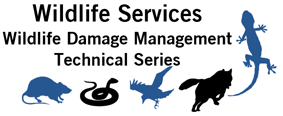U.S. Department of Agriculture: Animal and Plant Health Inspection Service
Date of this Version
2020
Document Type
Article
Citation
Taylor, J.D. and J.P. Phillips. 2020. Black Bear. Wildlife Damage Management Technical Series. USDA, APHIS, WS National Wildlife Research Center. Fort Collins, Colorado. 30p.
Abstract
The American black bear (Ursus americanus, Figure 1) is a challenging species for wildlife agencies to manage due to its size, intelligence, extensive range, food habits, and adaptability, as well as societal views. In North America alone, agencies receive more than 40,000 complaints about black bear annually. Black bears are known as ‘food-driven’ animals, meaning most conflicts result from a bear’s drive to meet its nutritional needs. Not surprisingly, an overwhelming proportion of conflicts are related to their use of anthropogenic (human) food sources, such as garbage, bird food, and crops. Understanding what drives human-bear conflict is the first part of good management.
Methods to manage human-bear conflicts can be grouped into two general categories: proactive and reactive. Proactive management attempts to change human behavior and prevent conflict, or keep it from recurring. Examples of proactive management include removing attractants, education and awareness, and exclusion. Conversely, reactive management attempts to change bear behavior or results in the lethal removal of the bear. Prior to any management action, there are important factors that managers and homeowners should consider. First, many of the methods described herein are only permissible to licensed personnel, such as state and federal biologists and wildlife managers. It is up to the individual to know which strategies are legal by reviewing local laws and agency websites. Also, it is important to note that any action plan should consider the side effects of the action and include a system for monitoring efficacy (short and long-term reactions of the bear). Documenting the season, time of day, type of conflict, and any information about the bear(s) involved is important for monitoring results. Be aware that the removal of the offending bear may open up its territory to other bear and conflicts, if the cause of the conflict is not mitigated.
Included in
Behavior and Ethology Commons, Biodiversity Commons, Other Animal Sciences Commons, Other Ecology and Evolutionary Biology Commons, Population Biology Commons, Terrestrial and Aquatic Ecology Commons

